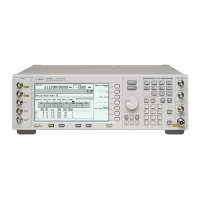Chapter 14 387
Real Time TDMA Formats
GSM Framed Modulation
Disabling Timeslot Ramping
1. Press Timeslot # > 1 > Enter.
2. Press
Multislot Off On to On.
3. Press
Return.
Turning multislot on disables ramping between the current and the next higher numbered (adjacent)
timeslot. A line underscores the timeslots where ramping is disabled. For this procedure, ramping will not
occur between timeslots one and two. The multislot choice is a setting for each timeslot.
Generating the Baseband Signal
Press GSM Off On to On.
This generates a GSM signal with an active access timeslot, an active custom timeslot, and an active normal
timeslot. The signal generator may require several seconds to build the signal. During this time, Baseband
Reconfiguring appears on the display. After the reconfiguration is complete, the display reads GSM On
and the GSM, ENVLP, and I/Q annunciators appear indicating that the signal is modulating the RF carrier.
Configuring the RF Output
1. Set the RF output frequency to 891 MHz.
2. Set the output amplitude to −5 dBm.
3. Press
RF On/Off to On.
The user-defined GSM signal is now available at the signal generator’s RF OUTPUT connector.
To store this real-time I/Q baseband digital modulation state to the instrument state register, see “Saving an
Instrument State” on page 71.
To recall a real-time I/Q baseband digital modulation state, see “Recalling an Instrument State” on page 72.
Adjusting the Power Level Between Timeslots
1. Press Amplitude > More (1 of 2) > Alternate Amplitude > Alt Amp Delta > –15 > dB.
2. Press
Mode Setup > Configure Timeslots > Timeslot # > 1 > Enter.
3. Press
Timeslot Ampl Main Delta to Delta.
The power level for timeslot one is now 15 dB lower than the other active timeslots. Selecting Main on the
Timeslot Ampl Main Delta softkey returns the timeslot to its previous power level. The delta amplitude choice
is available for each timeslot, however all timeslots use the same delta value set in the Alternate Amplitude
softkey menu.

